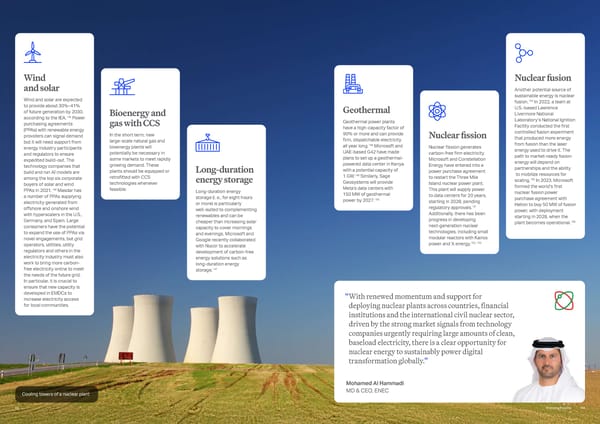Cooling towers of a nuclear plant Wind and solar Wind and solar are expected to provide about 30%–41% of future generation by 2030, according to the IEA.145 Power purchasing agreements (PPAs) with renewable energy providers can signal demand but it will need support from energy industry participants and regulators to ensure expedited build-out. The technology companies that build and run AI models are among the top six corporate buyers of solar and wind PPAs in 2021.146 Masdar has a number of PPAs supplying electricity generated from offshore and onshore wind with hyperscalers in the U.S., Germany, and Spain. Large consumers have the potential to expand the use of PPAs via novel engagements, but grid operators, utilities, utility regulators and others in the electricity industry must also work to bring more carbon- free electricity online to meet the needs of the future grid. In particular, it is crucial to ensure that new capacity is developed in EMDCs to increase electricity access for local communities. Bioenergy and gas with CCS In the short term, new large-scale natural gas and bioenergy plants will potentially be necessary in some markets to meet rapidly growing demand. These plants should be equipped or retrofitted with CCS technologies whenever feasible. Geothermal Geothermal power plants have a high-capacity factor of 90% or more and can provide firm, dispatchable electricity all year long.148 Microsoft and UAE-based G42 have made plans to set up a geothermal- powered data center in Kenya with a potential capacity of 1 GW.149 Similarly, Sage Geosystems will provide Meta’s data centers with 150 MW of geothermal power by 2027.150 Nuclear fusion Another potential source of sustainable energy is nuclear fusion.154 In 2022, a team at U.S.-based Lawrence Livermore National Laboratory’s National Ignition Facility conducted the first controlled fusion experiment that produced more energy from fusion than the laser energy used to drive it. The path to market-ready fusion energy will depend on partnerships and the ability to mobilize resources for scaling.155 In 2023, Microsoft formed the world’s first nuclear fusion power purchase agreement with Helion to buy 50 MW of fusion power, with deployment starting in 2028, when the plant becomes operational.156 Long-duration energy storage Long-duration energy storage (i. e., for eight hours or more) is particularly well-suited to complementing renewables and can be cheaper than increasing solar capacity to cover mornings and evenings. Microsoft and Google recently collaborated with Nucor to accelerate development of carbon-free energy solutions such as long-duration energy storage.147 Nuclear fission Nuclear fission generates carbon-free firm electricity. Microsoft and Constellation Energy have entered into a power purchase agreement to restart the Three Mile Island nuclear power plant. This plant will supply power to data centers for 20 years, starting in 2028, pending regulatory approvals.151 Additionally, there has been progress in developing next-generation nuclear technologies, including small modular reactors with Kairos power and X-energy.152, 153 “ With renewed momentum and support for deploying nuclear plants across countries, financial institutions and the international civil nuclear sector, driven by the strong market signals from technology companies urgently requiring large amounts of clean, baseload electricity, there is a clear opportunity for nuclear energy to sustainably power digital transformation globally.” Mohamed Al Hammadi MD & CEO, ENEC 84 Powering Possible 83
 Powering Possible 2024: AI and Energy for a Sustainable Future Page 42 Page 44
Powering Possible 2024: AI and Energy for a Sustainable Future Page 42 Page 44